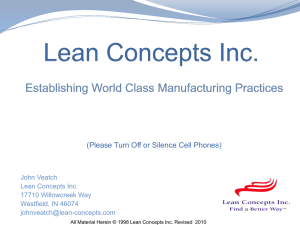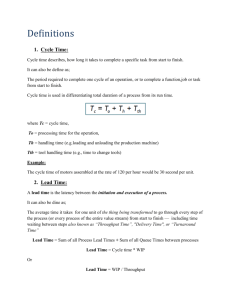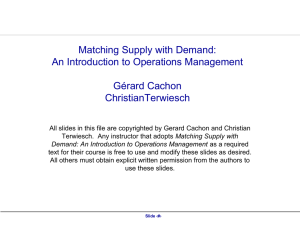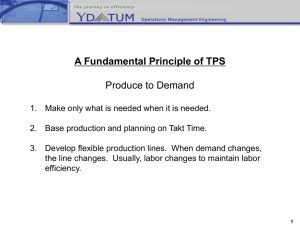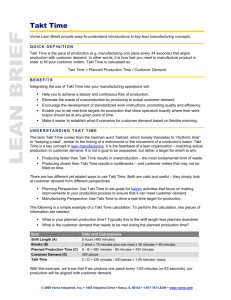Outline Continued
advertisement
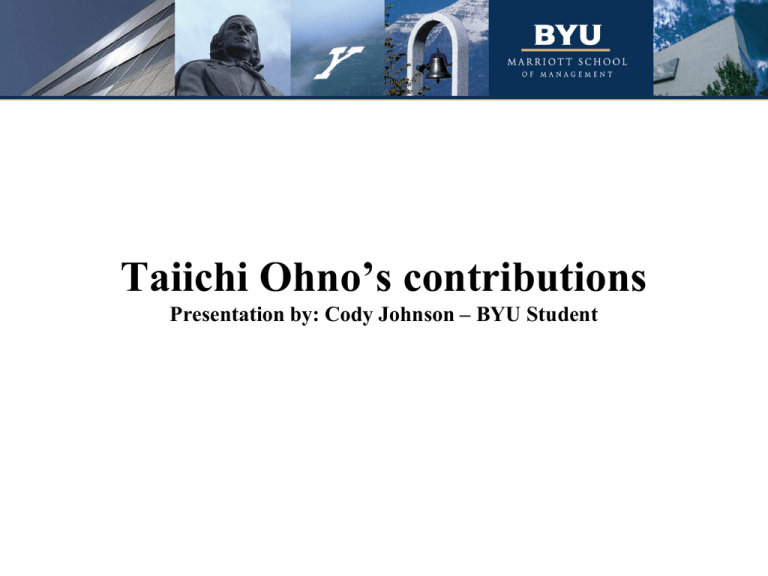
Taiichi Ohno’s contributions Presentation by: Cody Johnson – BYU Student Taiichi Ohno Contribution Outline • • • • • • • • Who is Taiichi Ohno? Key terms and meanings What is the Toyota Production System View the basics of the TPS Where do many of the ideas stem from Review the Seven Wastes Asking ‘why’ 5 times Stagnation = waste Outline Continued: • Key component to TPS – JIT – What is it? • Brainstorming Activitiy – Takt Time • Key Componenet to TPS explained – Kanban System • Summary • Sources/Readings List Taiichi Ohno Who is Taiichi Ohno? Born in China but known as a Japanese Businessman What is he known for? Being the father of the Toyota Production System (TPS) Ohno drove development and practical application of the TPS Believed in teaching leadership by example and empowering employees Quote from Ohno: “Costs do not exist to be calculated, they exist to be reduced.” Key terms and meanings • • • • • • • • Just-in-time: getting what is needed at the time it is needed in the quantity needed (JIT) Kanban: Simple, clear, fast means of communication Autonomation: separation of machine and man Muda: Waste, anything that is non-value added Poka-Yoke: A failsafe, instruments in place to avoid mistakes Heijunka: The discipline of leveling customer demand (Quantity and Variety) Kaizen: continuous improvement Takt Time: referred to as the time it takes to assemble products in each stage of the manufacturing process • Jidoka: automation with a human touch What is the Toyota Production System? *Two main pillars* • Continuous Improvement - often referred to as Kaizen • Respect for People The Basics of TPS Heijunka – Preexisting condition – Keep it level JIT a. Pull System b. Continuous Flow c. Takt Time JIDOKA a. Stop and Fix b. Separate Human & Machine Create flow of parts and seek people contributing to the company Where did Toyota get their ideas for the TPS? •Experiencing major material shortages because of the war •Henry Ford and his book •US Supermarkets – Saw replenishment and product delivery Ford Model T - 1908 The Seven Wastes of the TPS – ‘MUDA’ •Overproduction •Waiting •Transporting •Too much machining (Over-processing) •Inventories •Moving •Making defective parts and products You must first understand the nature of waste before it can be recognized Asking ‘Why’ 5 times • Critical component of problem solving • Goal: find the root cause of the problem • The direct root cause should point to a process after asking the 5 whys What is stagnation and how do we eliminate waste? Products are always changing -How can we add value We must have a continuous flow *Stagnation is considered waste, no matter what form it is in. Keep the flow with Takt Time Just-in-time (JIT) • • • • Developed to eliminate inventory Produce What is needed At the time it is needed In the Quantity needed ACCOMPLISHED • Pull Systems (Kanban signals) • Keeping Takt Time (pace of sales) Brainstorming Activity – Takt Time Formula for Takt Time = Time Available Customer Demand Time Available = Amount of scheduled work time per shift EXAMPLE: 8.00 hrs. per shift – minus .80 hrs of break and lunch = 7.2 hours of work time We need to convert minutes to seconds: 7.2 hours X 60 min.= 432 min. Per Shift the available time = 25,920 seconds 432min.X 60 sec.= 25,920 sec. Brainstorming Activity – Takt Time Now that we have ‘Time Available’, we need to compute customer demand. Customer Demand (Parts Required) = Demand per shift Weekly Demand = Demand per shift # of Shifts per week EXAMPLE: 27,000 demand per week 10 shifts per week = 2,700 units per shift Brainstorming Activity – Takt Time EXAMPLE: Takt time = Time Available Parts Required (Customer Demand) = 25,920 seconds per shift = 9.6 seconds per unit 2,700 units per shift *Every 9.6 seconds one unit should be produced* What if we are running faster than Takt Time? What if we are running slower than Takt Time? • Inventory increases • Lead times increase • Demand on suppliers increase • Cost increase • Overtime needed to meet demand • Product increases in cost • Shipping costs will increase • Customer dissatisfaction • Missed shipments Kanban system • A pull system – What is a pull system? Pull – means that nobody upstream will produce goods or services until the customer downstream asks for it VS. Push – means produce even if there is no demand Supplier How does a Kanban Pull system work? Inventory “Shop Stock” *This side you are seeing the flow of material Final Assembly Store/Shipping Dock *This side you are seeing the flow of information. A signal is sent to notify that more material is needed. Customer Summary • • • • • Much to learn about the TPS concepts Terms are simple and straightforward Identify the seven wastes Asking ‘why’ 5 times can make a difference JIT and Kanban – if implemented correctly, can be extremely beneficial for your organization • Always be looking for waste – WASTE = $$ Readings list: Sources • ‘Toyota Production System’ written by Taiichi Ohno. • ‘The Toyota Way’ written by Jeffrey Liker • I worked at US Synthetic in Orem, Utah and took a Lean certification class. They base much of their manufacturing off of the TPS. I received a lot of information from my research from the hand book for this certification class through US Synthetic
